Physical Address
304 North Cardinal St.
Dorchester Center, MA 02124
Thin rete with bulbous tips “dipped in chocolate”
Reticulated seborrheic keratosis looks similar to a lentigo but with anastomosis of rete and horn cysts.
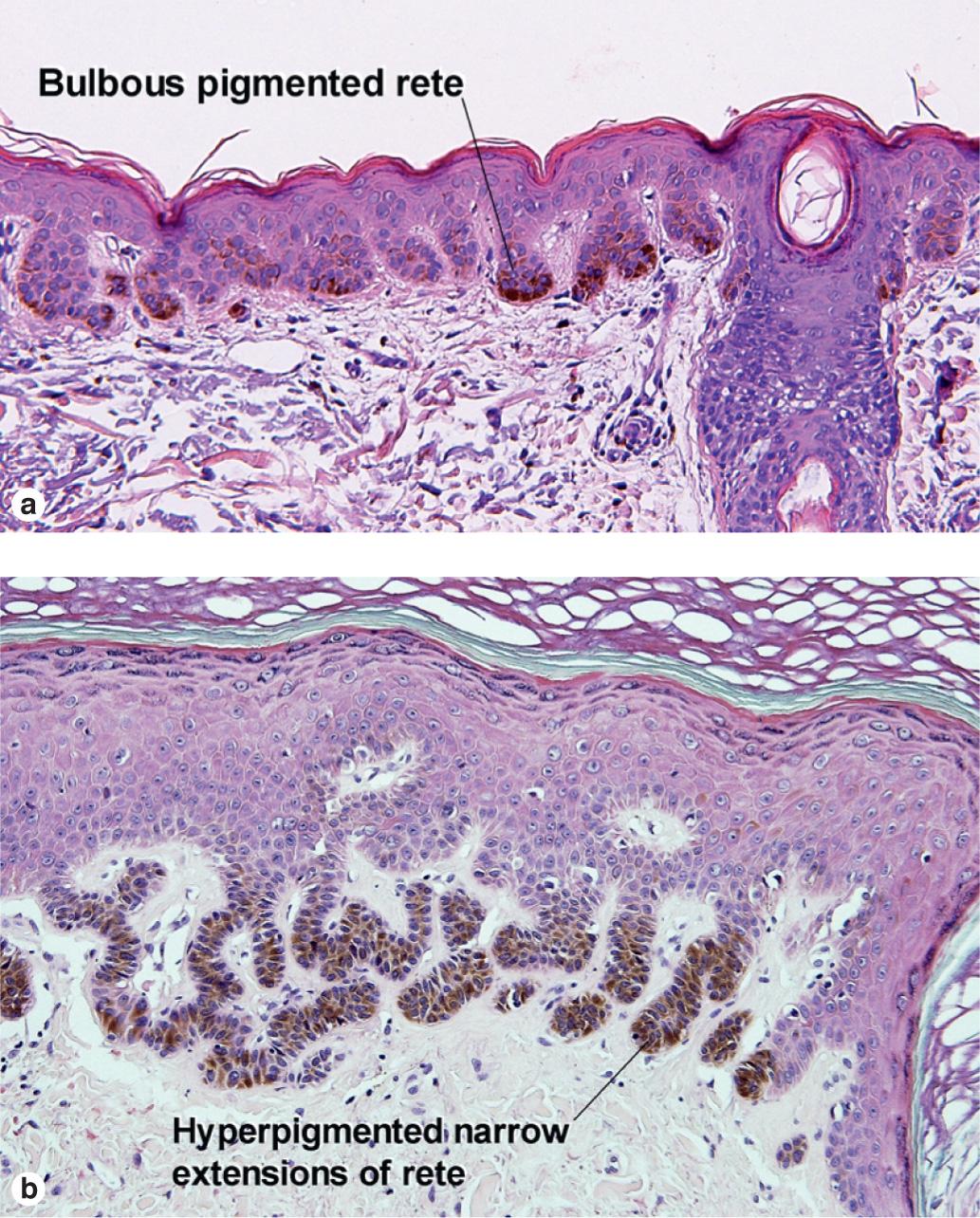
Common on the lips and genitalia
Rete are broad and squared-off with pigment at basal layer
Melanotic macules are typically light brown and evenly pigmented, but those in the genitalia may sometimes have strikingly irregular pigment. The histologic changes are the same, regardless of location and clinical appearance.
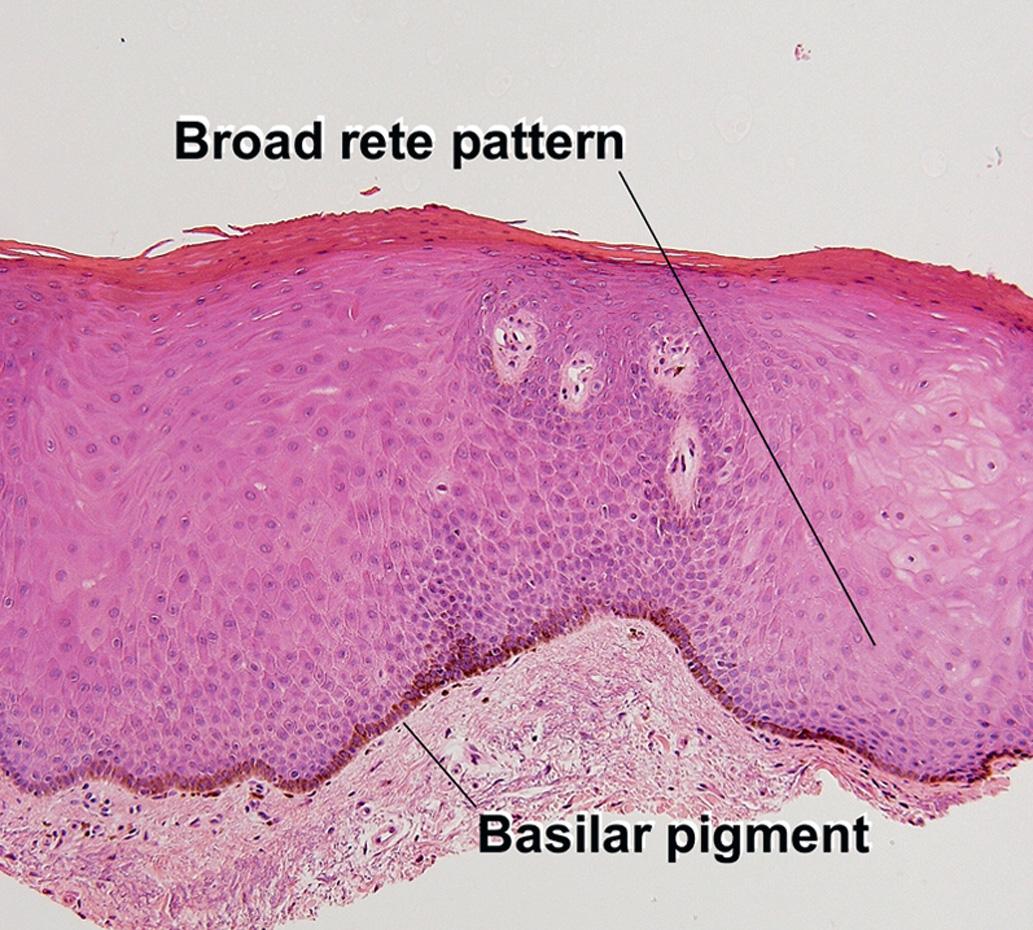
Benign nevi are bilaterally symmetrical from right to left, but they are asymmetrical from top to bottom. In contrast, melanoma metastases are radially symmetrical in all directions, like a cannonball.
A biopsy of a nevus demonstrates a discrete, well-nested melanocytic proliferation in the upper portion of the lesion. Melanocytes disperse into individual units in the deeper portions of the lesion. Maturation refers to melanocytes becoming progressively smaller and spindled in the deeper portions of the lesion. Melanin should not be present in deep melanocytic nests, although melanophages may be present. In cases with questionable maturation, top-heavy HMB-45 immunostaining (loss of staining in the deep component) is a surrogate marker of maturation. Deep mitoses are absent. In unusual lesions, MIB-1 immunostaining is sometimes performed. MIB-1 is expressed in all active phases of the cell cycle—G1, M, G2, and S phase (but not resting G0)—and is not a mitotic marker. There should be no staining of deep melanocytic nuclei.
Broad junctional lesions on heavily sun-damaged skin are usually melanoma, regardless of how bland they appear.
Small, well-nested lesions are almost always benign.
Horn cysts can occur in the epidermis overlying melanocytic lesions. Horn cysts visible with dermoscopy are not diagnostic of seborrheic keratosis.
Epithelial crypts are common in conjunctival nevi.
Table 6.1 gives general rules and is a good starting point for the evaluation of pigmented lesions. There are exceptions to the rules. For example, blue nevi show no evidence of maturation or dispersion. They are commonly deeply pigmented to the base of the lesion. They are readily recognized by their wedgelike or bulbous outline and characteristic cytologic features.
| Characteristic | Nevus | Melanoma |
|---|---|---|
| Lateral circumscription | Sharp | Variable |
| Bilateral (right to left) symmetry | Yes | Commonly asymmetrical |
| Top to bottom symmetry | No | Variable |
| Size | Small | Usually quite broad |
| Dermal–epidermal junction | Well nested | Nonnested melanocytes usually outnumber nests in areas |
| Shape of junctional nests | Round to oval | Often elongated and bizarre |
| Location of junctional nests | Tips and sides of rete | Tops of dermal papillae often involved as well |
| Spacing of junctional nests | Regular | Usually irregular |
| Buckshot scatter in epidermis | Absent except in the center of Spitz nevi, pigmented spindle cell nevi, acral nevi, traumatized nevi, and sunburned nevi | Variable (present in superficial spreading malignant melanoma, usually not prominent in lentigo maligna and acral lentiginous malignant melanoma) |
| Maturation | Cells become smaller and more neuroid from top to bottom | Typically fails to mature |
| Dispersion | Disperses to single units at base of lesion | Generally remains nested at base |
| Junctional vs. dermal nests | Dermal nests smaller than junctional nests; from top to bottom, nests become smaller, melanocytes disperse | Dermal nests often larger than junctional nests |
| Deep mitoses | Rare | Variable |
| Deep pigment | No | Variable |
| HMB-45 | Top heavy | Commonly stains strongly to base |
| MIB-1 | No deep nuclei positive | Deep nuclei commonly positive |
| S100A6 | Spitz nevi usually stain diffusely | Usually patchy |
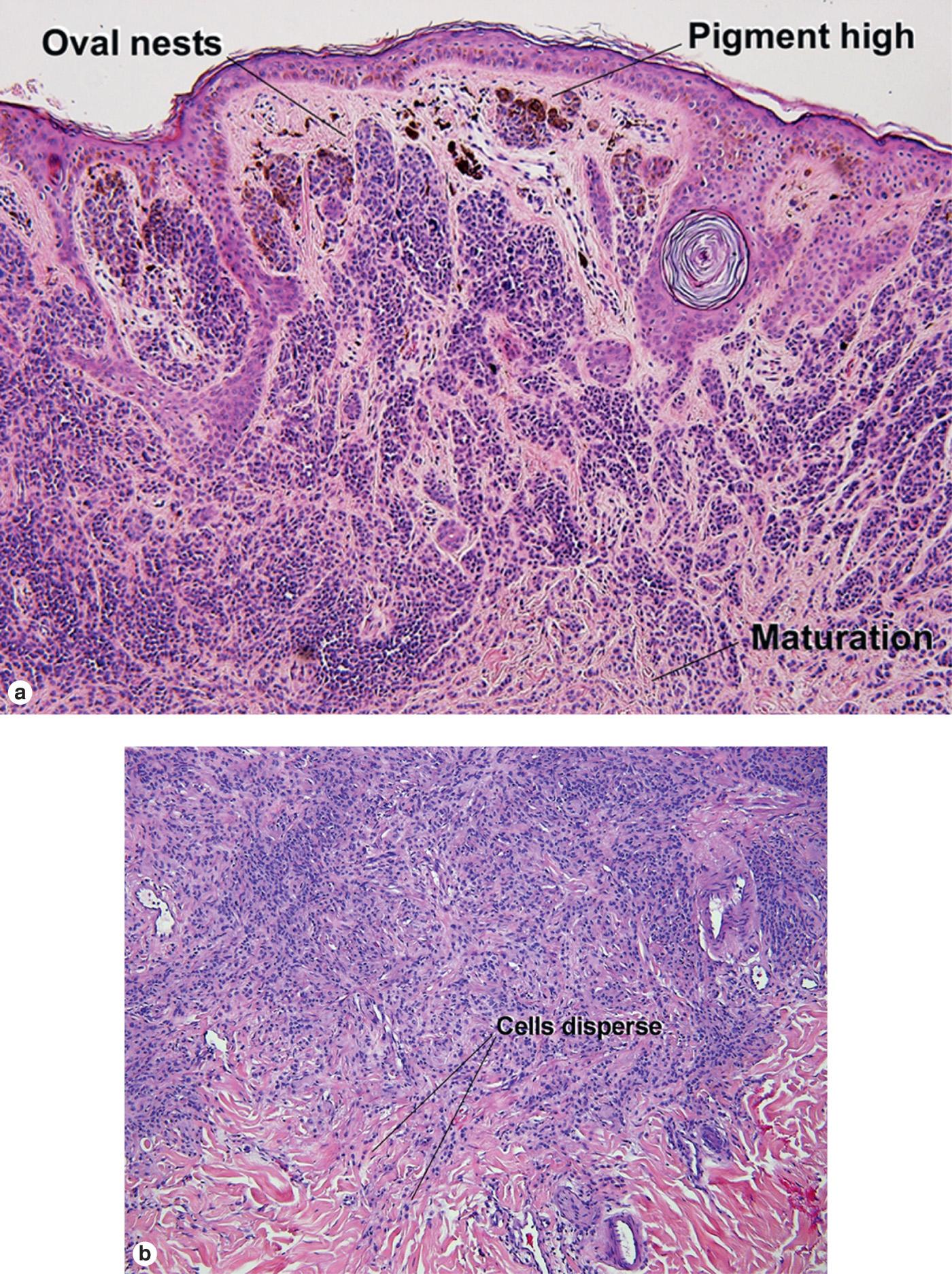
Balloon cells
Sharply defined
Well nested at the dermal–epidermal junction
Matures
Disperses at the base of the lesion
No deep mitoses
No deep pigment in melanocytic nests
Balloon change is a degenerative feature. Ultrastructurally, it is characterized by swelling of cellular organelles.
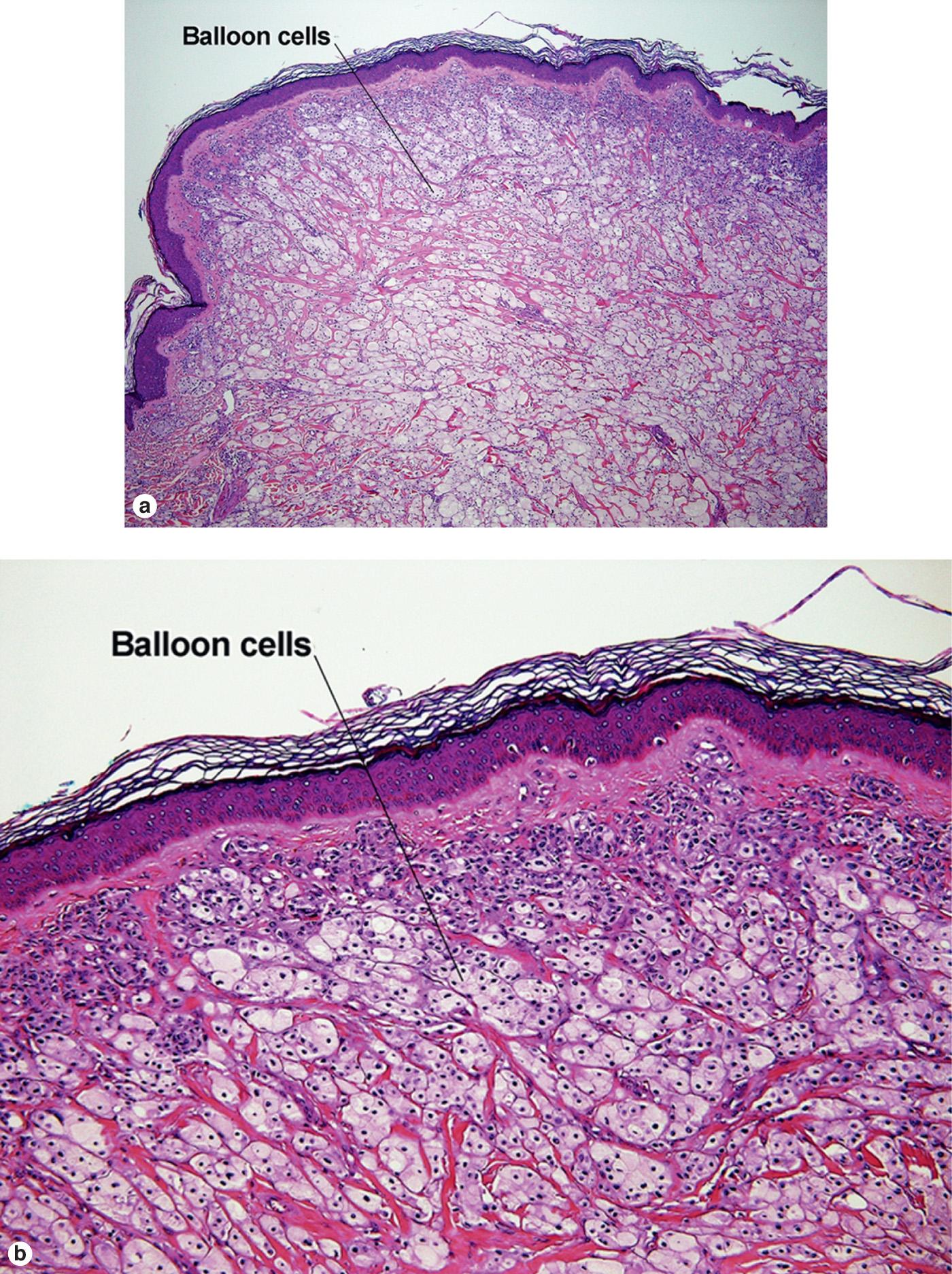
S-shaped spindle cells similar to those of a neurofibroma
Nevic corpuscles resembling Meissner corpuscles
Sharply defined
Disperses at the base of the lesion
No deep mitoses
No deep pigment
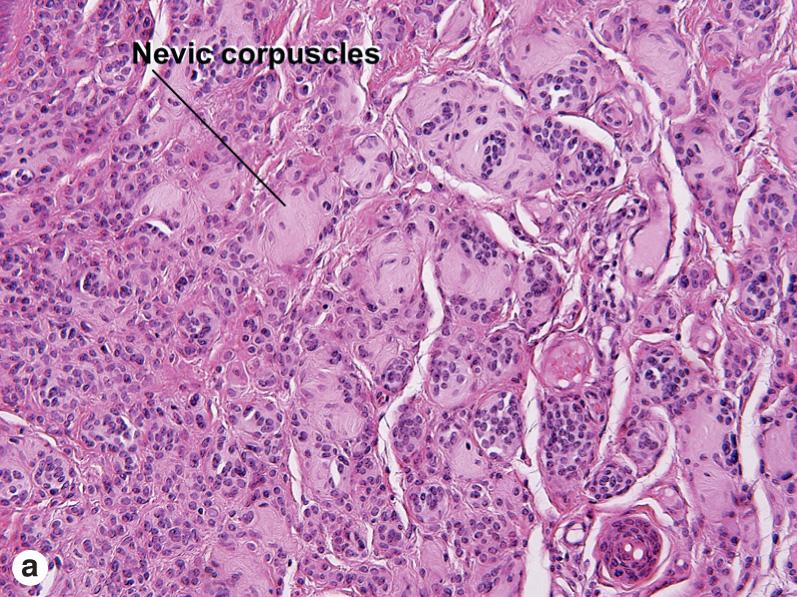
Broad
Bland cytologically
Matures
Cells disperse at base
Often within or aggregated about follicles, vessel walls, and nerves
Patchy perivascular pattern
Single-file interstitial pattern
A typical congenital nevus demonstrates a well-defined melanocytic proliferation with bland nuclei. The lesion is symmetrical from right to left, with a patchy perivascular, periadnexal, and interstitial pattern. Cells mature and disperse in the deeper portions of the lesion.
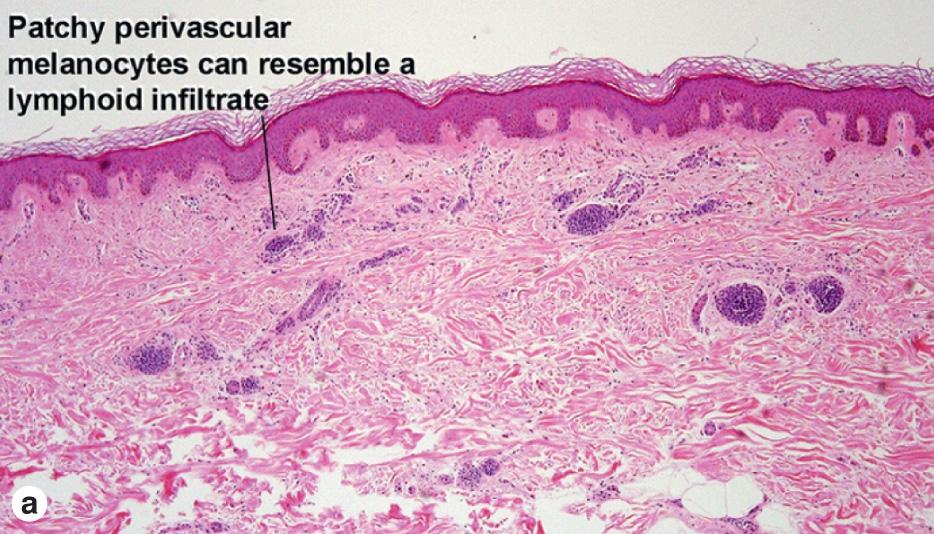
Hyperkeratosis, hypergranulosis, pseudoepitheliomatous hyperplasia (PEH) a
a These features are only seen if a dermal component is present.
Well nested at the dermal–epidermal junction a
Nests vertically oriented along rete (“raining-down pattern,” “bananas on the tree”) a
Melanocytes within the nests share the vertical orientation a
Clefts around nests a
Kamino bodies a
Large spindle and epithelioid cells
Nuclei as large as or larger than keratinocyte nuclei
Nuclei vesicular with prominent nucleoli
Two-tone cytoplasm
Sharply defined laterally
Line symmetry from left to right
Matures from top to bottom
Disperses at the base of the lesion
No deep mitoses
No deep pigment in nests
Buckshot scatter OK in center of lesion a
These features are only present if there is a junctional component
Benign spindle and epithelioid cell (Spitz) nevi occur in adults, but most commonly present as pink papules on the face or scalp of a child. Unfortunately, melanomas can demonstrate large spindle and epithelioid cells, hyperkeratosis, hypergranulosis, and pseudoepitheliomatous hyperplasia. These features are especially common among melanomas in the pediatric age group. Critical distinguishing features include sharp lateral circumscription, maturation, and dispersion, all of which should be present in benign Spitz nevi. Deep mitoses should be absent. Kamino bodies are dull pink areas of trapped basement membrane material within the epidermis. They stain blue to green with a trichrome stain and mark with immunostains for type IV collagen.
In lesions with any atypical feature, immunostaining is commonly performed. HMB-45 immunostaining should be top-heavy, and the lesion should stain diffusely for S100A6. MIB-1 staining should be absent in melanocyte nuclei at the base of the lesion.
Comparative genomic hybridization and chromosome deletion analysis by fluorescent in situ hybridization are promising techniques. The majority of Spitz nevi have a normal chromosome complement. Some large Spitz nevi have an 11p gain.
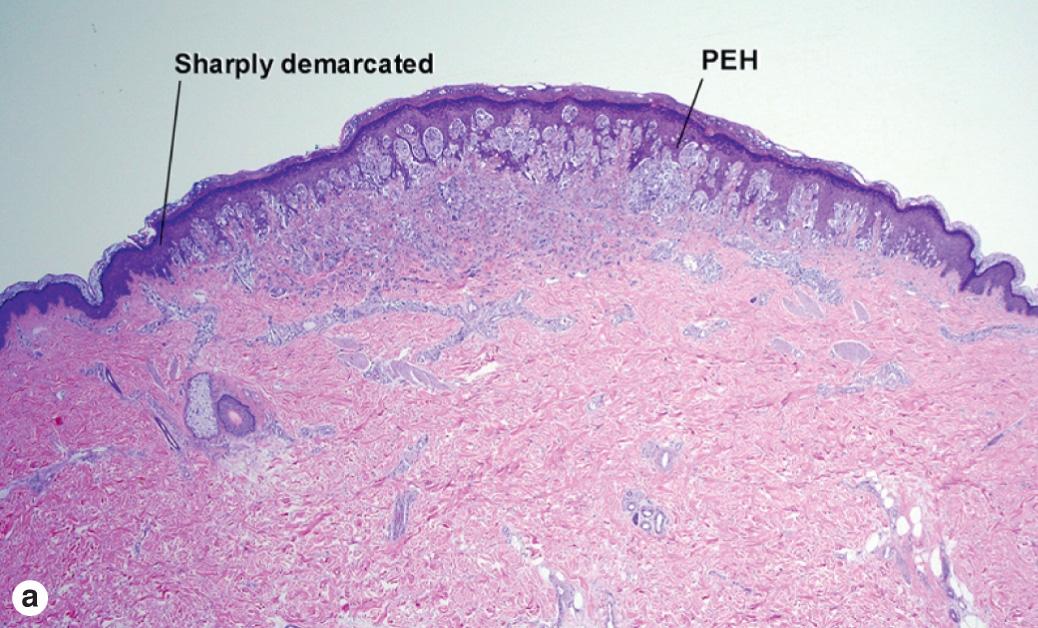
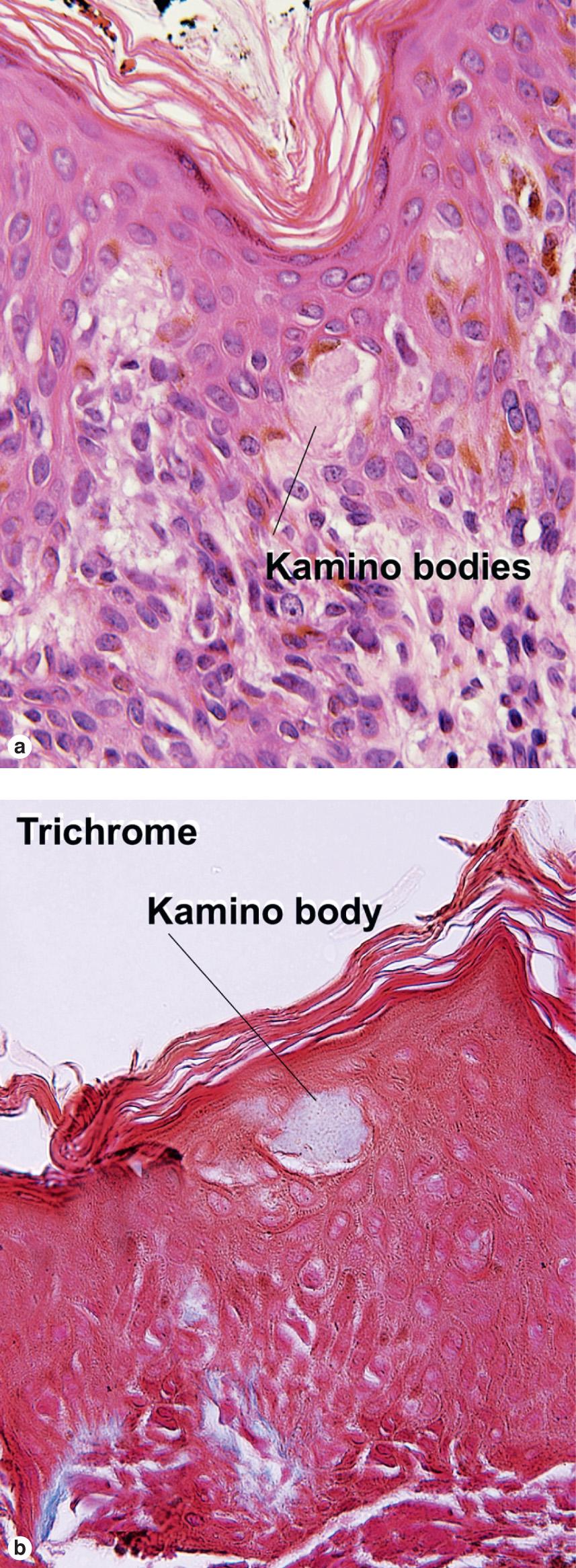
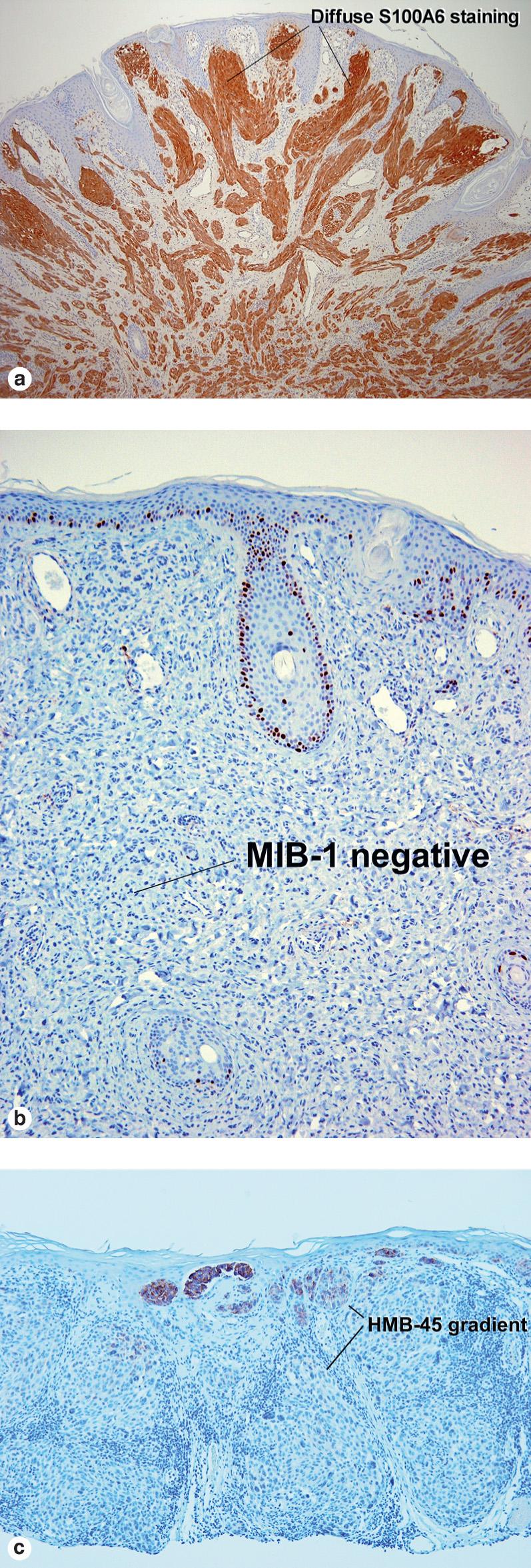
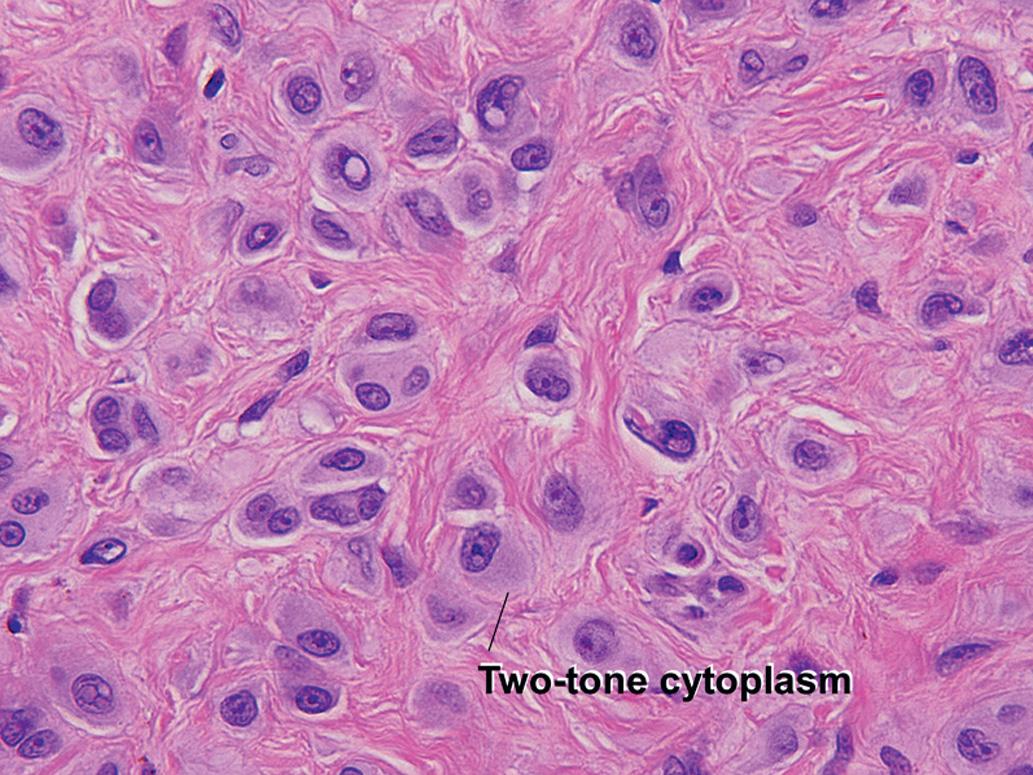
Buckshot intraepidermal scatter of large epithelioid melanocytes
Hyperkeratosis variable
Relatively small and very sharply circumscribed lesions of children and young adults
Lack nuclear pleomorphism and hyperchromasia
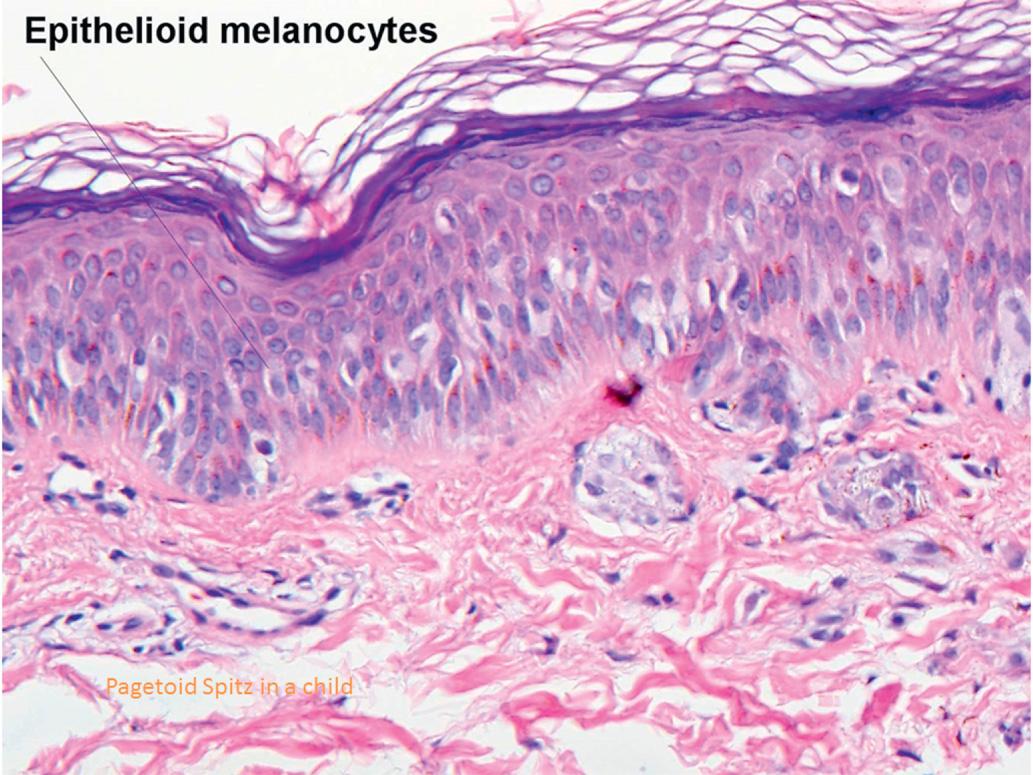
Hyperkeratosis, hypergranulosis, pseudoepitheliomatous hyperplasia
Well nested at the dermal–epidermal junction
Clefts around nests variable
Kamino bodies variable
Small spindle cells
Sharply defined
Line symmetry from left to right
Matures from top to bottom if compound
Disperses at the base of the lesion if compound
No deep mitoses
No deep pigment in nests
Buckshot scatter OK in center of lesion
Benign pigmented spindle cell nevus is considered by many to be a variant of Spitz nevus. They typically present as deeply pigmented macular lesions on the thighs or lower legs of young women. The spindled melanocytes are smaller than those in a Spitz nevus. Epithelioid cells are rare.
| Characteristic | Spitz nevus | Pigmented spindle cell nevus of Reed |
|---|---|---|
| Age | Children | Young women |
| Color | Usually pink | Usually dark brown |
| Location | Head | Legs |
| Hyperkeratosis, hypergranulosis, and pseudoepitheliomatous hyperplasia | Yes | Yes |
| Cytology | Large spindle and epithelioid cells | Small spindle cells |
| Kamino bodies | Common | Variable |
| Buckshot scatter in epidermis | Normal in center lesion | Normal in center lesion |
| S100A6 | Strongly + | Weak and patchy |
Occur in the anogenital region, axillae, umbilicus, breast, scalp, ears
One pattern resembles a dysplastic nevus
Second pattern characterized by large junctional nests that appear poorly cohesive (white space surrounding each melanocyte)
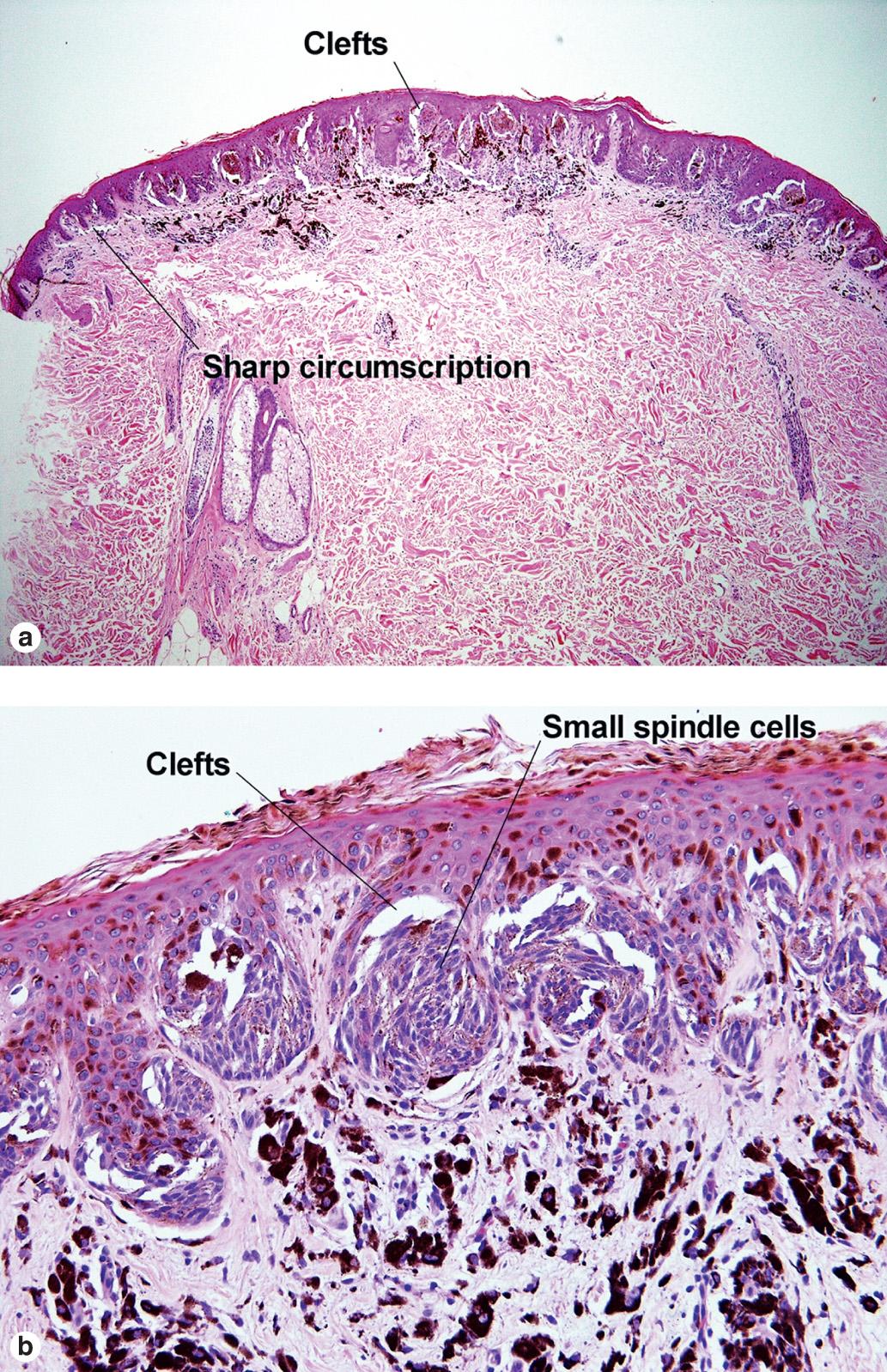
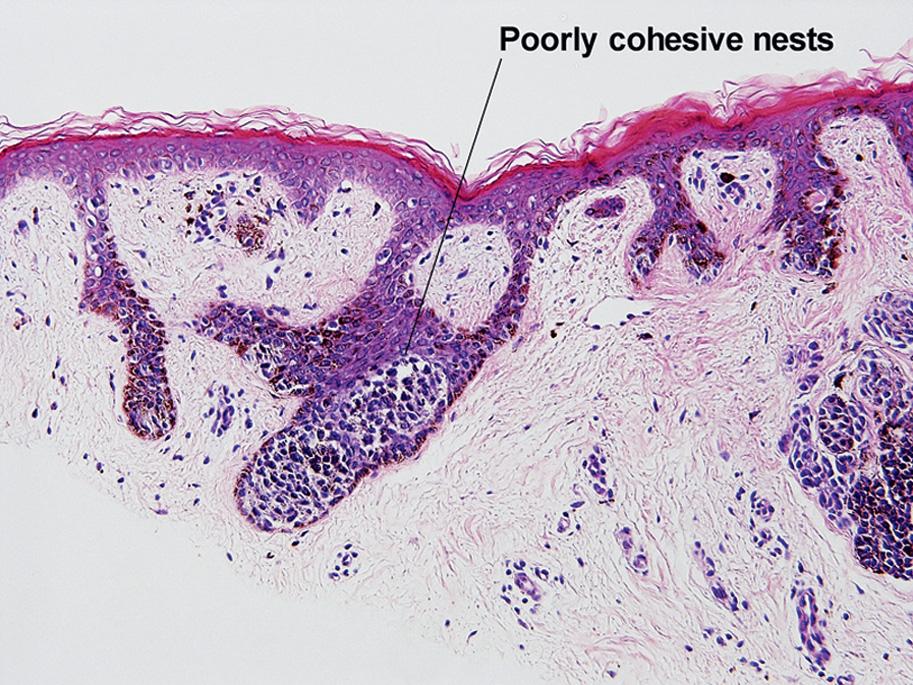
On volar skin, nests are commonly elongated and follow dermatoglyphs
Buckshot scatter OK in center of lesion
Sharply defined
Well nested at the dermal–epidermal junction
Matures
Disperses at the base of the lesion
No deep mitoses
No deep pigment in melanocytic nests
Within the central portion of an acral nevus, melanocytes are commonly noted above the dermal–epidermal junction. As long as it is confined to the center of the lesion, “buckshot scatter” by itself is not a worrisome feature in an acral nevus.
If volar nevi are bisected perpendicular to the dermatoglyphs, the nests will appear round. The rete pattern will be regular. If they are inappropriately sectioned parallel to the dermatoglyphs, the nests will appear long and confluent. The rete pattern may appear effaced in such sections. Oblique sections will give the appearance of irregular nesting and Swiss-cheese rete. It is important to communicate carefully with the laboratory when submitting a specimen from acral skin. Some clinicians prefer to bisect the specimen themselves, perpendicular to the dermatoglyphs.
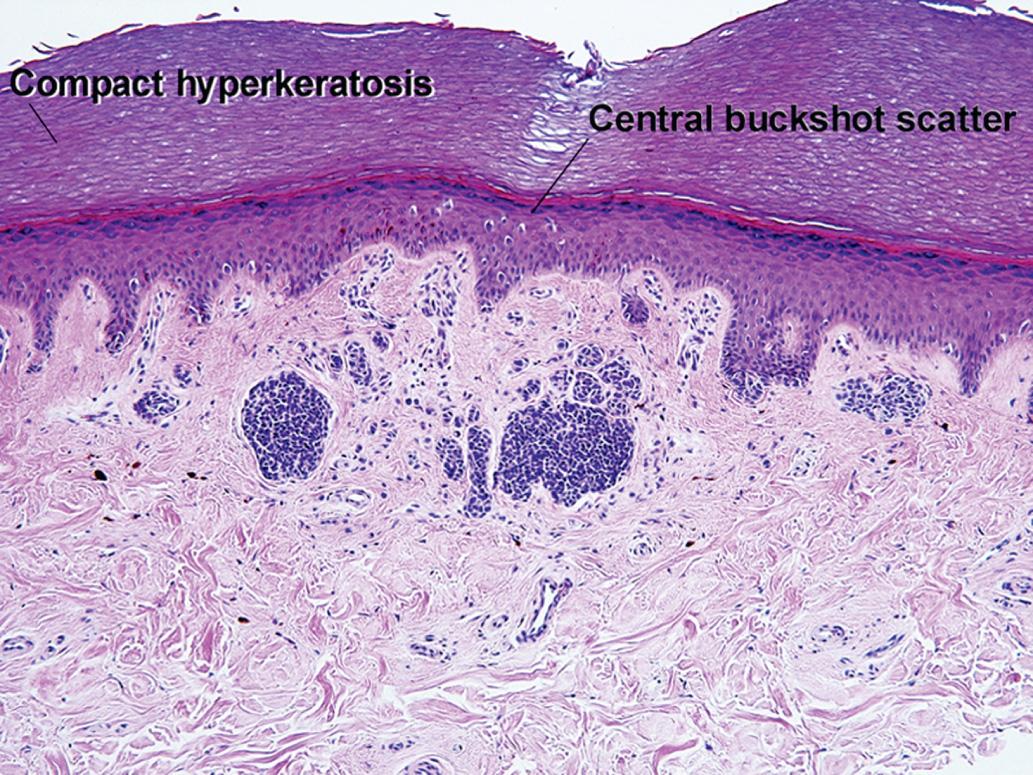
Become a Clinical Tree membership for Full access and enjoy Unlimited articles
If you are a member. Log in here